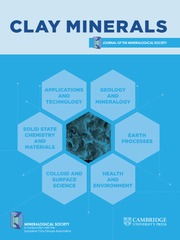No CrossRef data available.
Article contents
Effect of calcium solution on the mineralogy of the clay fraction and the swelling of clay soils
Published online by Cambridge University Press: 21 July 2025
Abstract
This article addresses the subject of treating clayey soils to reduce the swelling in this type of soil. The study used a calcium-rich solution and examined the influence of this solution on the <2 μm clay fraction, on the non-clay fraction and on clay soil swelling. The dissolution of clay-fraction minerals during this treatment was also examined. A mineralogical and free-swelling analysis was carried out on three natural clay soils from three different locations in Algeria. The solution rich in Ca ions had a significant influence on clay mineralogy, as all the clay minerals nearly disappeared and only traces of smectite, illite, chlorite and kaolinite remained. The almost complete disappearance of minerals after contact with the Ca solution may be linked to the high pH of the porewater, because an increase in pH accelerates the alteration of these minerals. The pH of the solution induced significant modifications in the samples, revealing the high reactivity of the minerals during this treatment. Furthermore, the treatment allowed for a nearly total reduction of the sensitivity of these soils to water (i.e. swelling).
Information
- Type
- Article
- Information
- Copyright
- © The Author(s), 2025. Published by Cambridge University Press on behalf of The Mineralogical Society of the United Kingdom and Ireland.
Footnotes
Associate editor: Javier Huertas

